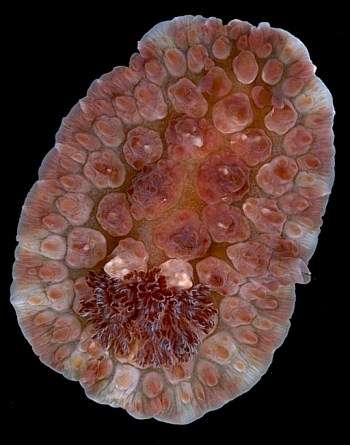
Dendrodoris carbunculosa
(Kelaart, 1858)
Order: NUDIBRANCHIA
Suborder: DORIDINA
Family: Dendrodorididae
DISTRIBUTION
Tropical Indo-West Pacific.
PHOTO
UPPER RIGHT: Plateau Karembé, near Koumac, New Caledonia, 20°38'S, 164°16'. Intertidal, mixed substrate, sand and coral blocks 24 October 1993, 100mm long. PHOTO: Bill Rudman.
LOWER RIGHT: As above.
LOWER LEFT: Broadhurst Reef, Townsville, Queensland, Australia, July 1975, 270mm long. Photo: Ian Loch.
Earlier workers, (Eliot, Alder & Hancock, Bergh) considered that Kelaart's species was probably just a variety of Dendrodoris tuberculosa (Quoy & Gaimard, 1832), differing only in the colour of the underside of the mantle. In Dendrodoris tuberculosa there are characteristic large white oval spots, while in Dendrodoris carbunculosa the underside of the mantle is a uniform brown or reddish brown, sometimes with darker diffuse patches. The colour and shape are clearly seen in Kelaart's unpublished paintings in the Natural History Museum, London. This species differs in having large individual tubercules separated by smooth sections of the mantle. Each large tubercle is surrounded by a ring of small semispherical bumps. In Dendrodoris tuberculosa the tubercules are packed close together and are often compound. It is possible that these two `species' are opposite extremes of a range of variation, but I have neither seen nor read of the existence of any intermediate forms.
Ian Loch reports that the mucous secretions of an animal he collected in Townsville caused painful burning sensations to his lips and eyes - presumably via his hands.
See Kelaart paintings on Page 2.
Reference:
• Kelaart, E.F. (1858). Description of new and little known species of Ceylon nudibranchiate molluscs and zoophytes. Journal of the Ceylon Branch of the Royal Asiatic Society,
Columbo, 3(1): 84-139.
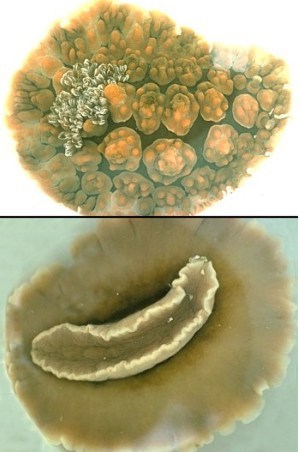

Rudman, W.B., 1998 (December 20) Dendrodoris carbunculosa (Kelaart, 1858). [In] Sea Slug Forum. Australian Museum, Sydney. Available from http://www.seaslugforum.net/find/dendcarb
Related messages
Dendrodoris carbunculosa from French Polynesia
April 9, 2010
From: Peter Brink
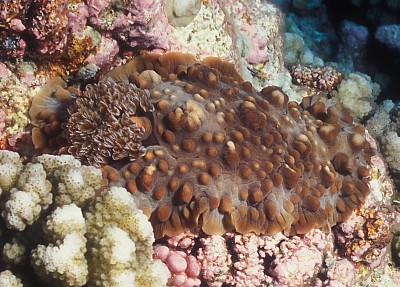
While diving in French Polynesia the dive guide found a nudibranch which we believe is an example of Dendrodoris carbunculosa. It was approximately 5 inches long. The depth was 35 feet on a ocean reef facing north near the Northern pass of Fakarava. Lat/Long 16.04.41.07 S/145.42.36.02W
We can not find any other reference indicating the presence of this species in French Polynesia.
We only found this nudibranch once on 22 September 2009. We dived the site 6 other times but never found the nudibranch again.
Locality: North side of the North Pass on Fakarava near the town of Rotova, 35 ft, French Polynesia, South Pacific , 22 september 2009, healthy reef, visability over 100ft. Length: 5 inches. Photographer: Peter Brink.
Peter Brink
Peter.Brink@sunysb.edu
Brink, P.R., 2010 (Apr 9) Dendrodoris carbunculosa from French Polynesia. [Message in] Sea Slug Forum. Australian Museum, Sydney. Available from http://www.seaslugforum.net/find/23430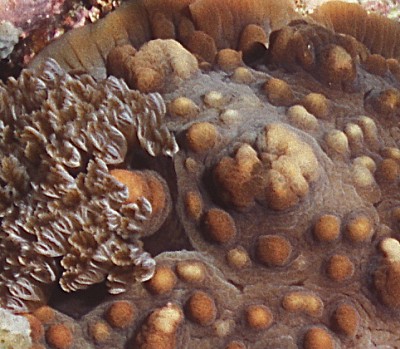
Dear Peter,
Yes this is D. carbunculosa. It is a bit difficult to know whether this species has been reported from French Polynesia because until I resurrected the name on the Forum, about 10 years ago, it hadn't been used. It is possible specimens of this species have previously been recorded as D. tuberculosa.
Usually the compound tubercles on the back are spaced slightly apart, but in your animal they are wedged closely together
Best wishes,
Bill Rudman
Phyllidia mimic from sthn Queensland
March 4, 2009
From: Gary Cobb
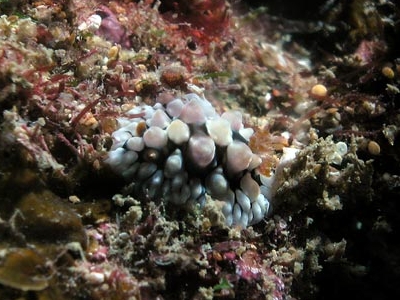
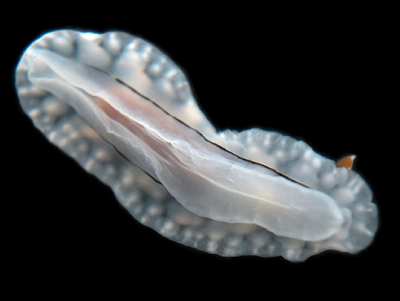
Concerning message #20053:
Hi Bill and everyone!
After reading message #20053 I thought I would send you my version. We are calling it a juvenile Dendrodoris tuberculosa but there seems to differences. The black line between the foot and mantle and lack of white spots along with black areas between the tubercles. Also it seems that some folk see D. carbunculosa as synonym of D. tuberculosa.
Locality: Mooloolaba, Sunshine Coast, 18 m, Queensland, Australia, Pacific Ocean, 01 March 2009, Subtidal. Length: 18 mm. Photographer: Gary Cobb.
The Forum's thoughts...
Thanks Gary
www.nudibranch.com.au
gary@nudibranch.com.au
Cobb, G.C., 2009 (Mar 4) Phyllidia mimic from sthn Queensland. [Message in] Sea Slug Forum. Australian Museum, Sydney. Available from http://www.seaslugforum.net/find/22299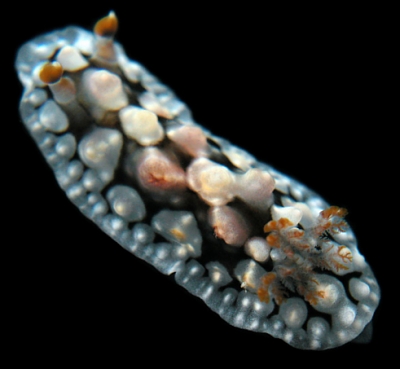
Dear Gary,
As I discussed in the message you refer to I cnsider this is probably a juvenile form of D. carbunculosa. There is always a possibility that it, and the similar animals in earlier messages are a distinct species, but if so, I am sure they are not D. tuberculosa.
You mention that 'some folk see D. carbunculosa as synonym of D. tuberculosa'. It is helpful in scientific discussions to have a reference to who such folk are and why they feel that way. I introduced this old name into modern use in the Forum 10 years ago and discuss the differences between the two species in the two species Fact Sheets. Externally the shape of the dorsal mantle tubercules and their distribution, is quite different, being crowded together in D. tuberculosa and widely spaced in D. carbunculosa. Also, in D. tuberculosa their are large white spots on the underside of the mantle while in D. carbunculosa the underside of the mantle is translucent to opaque white and their are no spots.
I would welcome comments from others.
Best wishes,
Bill Rudman
Re: Phyllidia mimic from Indonesia
June 20, 2007
From: Philibert Bidgrain
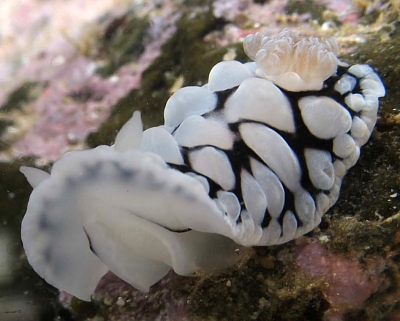
Concerning message #19370:
Dear Bill,
Reunion Island seaslug
For the discussion about this unidentified species, I send you three photos where we can see some detail of another specimen of this species found in our Island
Some remarks about our specimen:
The large five (or six?) compound gills which form a circle around the anus emerge from a deeply lobed branchial pocket. The mantle is soft, and a black line runs between the foot and the mantle.
Locality: Etang sale, less 1 m, Reunion Island, Indian Ocean, 13 December 2006, Rocky coast. Length: 20 mm. Photographer: Philibert Bidgrain.
We have observed Dendrodoris carbunculosa on our island, but the pattern is really different [see on our website]. I think that it will be another species ... I'm interested in any information about this species...
Best regards
Philibert Bidgrain
http://vieoceane.free.fr/runseaslug/indexslug.htm
pbidgrain@yahoo.fr
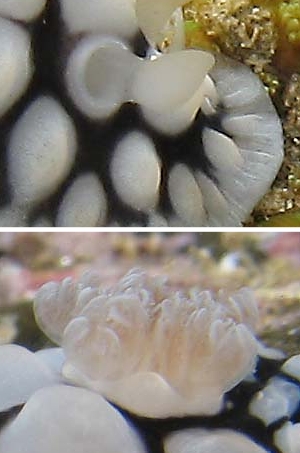
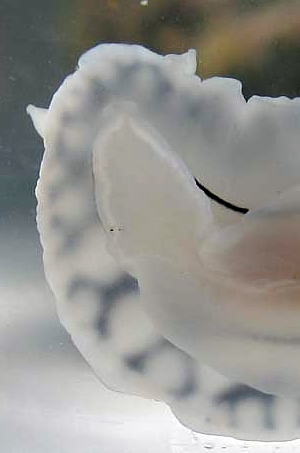
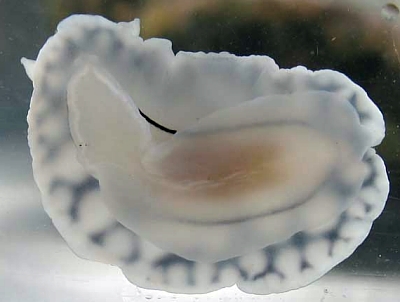
Dear Philibert,
Your photos only go to show how useful a photo of the underside of the animal is. From the shape of head - almost non-existent - I am now sure this is a species of Dendrodoris, and your upper photo shows the mantle is more rigid than I thought from Ken Tucker's photo. Also the lobes around the gill pocket are usual for dendrodorids such as D. carbunculosa. Also in the middle left photo I have a close-up of the rhinophore which shows it has the characteristic shape of these big warty dendrodorids. The only feature which doesn't seem to fit adult D. carbunculosa is the black line around the inside edge of the underside of the mantle. Perhaps this dark line turns into the very dark brown - black band present in many large specimens.
Your animal is indeed a Dendrodoris, and I now agree with Cory Pittman [#20045 ] and Erwin Koehler [#20047] who both suggested earlier today that Ken's animal might be a juvenile D. carbunculosa.
Best wishes,
Bill Rudman
Re: Phyllidia mimic from Indonesia
June 19, 2007
From: Erwin Koehler
Concerning message #19370:
Dear Bill,
maybe this is a juvenile Dendrodoris carbunculosa...
Regards
Erwin
Erwin@Philippine-Sea-Slugs.com
Koehler, E., 2007 (Jun 19) Re: Phyllidia mimic from Indonesia. [Message in] Sea Slug Forum. Australian Museum, Sydney. Available from http://www.seaslugforum.net/find/20047Note added 20 June 20007: This is probably a juvenile Dendrodoris carbunculosa [see message #20053]
Thanks Erwin,
That's just what Cory Pittman has suggested as well [#20045]. See my comments there. Certainly in colour they could be the same but I think one is soft and the other is tough and leathery.
Best wishes,
Bill Rudman
Re: Phyllidia mimic from Indonesia
June 19, 2007
From: Cory Pittman
Concerning message #19370:
Hi Bill,
I suspect this is a juvenile Dendrodoris carbunculosa.
Best wishes,
Cory
Cory@cet.com
Cory, C. C., 2007 (Jun 19) Re: Phyllidia mimic from Indonesia. [Message in] Sea Slug Forum. Australian Museum, Sydney. Available from http://www.seaslugforum.net/find/20045Note added 20 June 20007: This is probably a juvenile Dendrodoris carbunculosa [see message #20053]
Dear Cory,
It certainly has similarities to Erwin Koehler's photo [#412] but that animal seems to have a rigid mantle and the tubercles already have secondary tubercles developing. I may be wrong but Ken Tucker's animal looks quite soft, like a species of Chromodoris or a Dendrodoris, like D. nigra, rather than a tough leathery species like D. carbunculosa.
Best wishes,
Bill Rudman
Phyllidia mimic from Indonesia
June 18, 2007
From: Ken Tucker
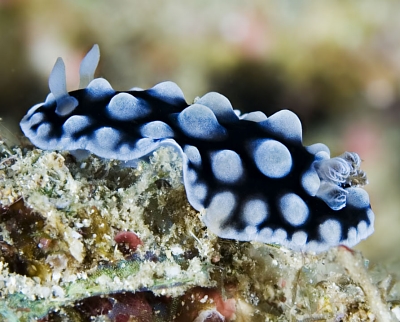
Seems a poor match for Glossodoris hikuerensis, though I cannot come up with a better candidate. I have two other photos, though I discern no additional distinguishing characteristics.
Locality: Bunaken Park - site Bolung, 12 metres, Indonesia, Sulawesi, 8 Nov 2006. Length: 2 cm. Photographer: Ken Tucker.
Ken Tucker
ken@kilili.com
Tucker, K., 2007 (Jun 18) Phyllidia mimic from Indonesia. [Message in] Sea Slug Forum. Australian Museum, Sydney. Available from http://www.seaslugforum.net/find/19370Note added 20 June 20007: This is probably a juvenile Dendrodoris carbunculosa [see message # 20053]
Dear Ken,
I feel I should know this species, which could be a mimic of some species of Phyllidia, but I don't recall it. [see mimicry page]. The gills look more like those of a dendrodorid than of Glossodoris or any other chromodorid.
If anyone has any clues please let us know
Best wishes,
Bill Rudman
Dendrodoris carbunculosa detail from N. Sulawesi
November 26, 2005
From: Linda Ianniello
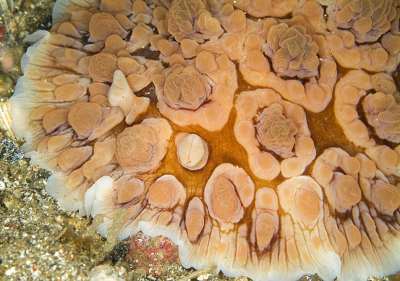
I found this large Dendrodoris carbunculosa and gave up trying to shoot the whole slug and went for a "head" shot. Thus the good details of the texture, which I hope will add to the information on the Forum.
Locality: Lembeh Strait, Nudi Falls dive site, Indonesia, N. Sulawesi Island.
October 28, 2005. Muck dive. Photographer: Linda Ianniello
Regards,
Linda I.
lindai1@bellsouth.net
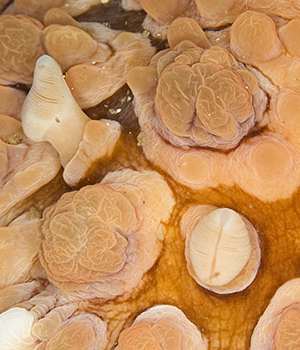
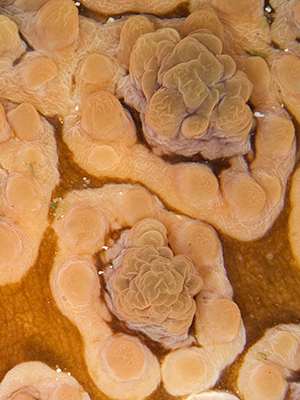
Thanks Linda,
I sympathisae with your problem. Photographing something 'big' when you are organised for 'small' can be a real problem. It's the same problem when it comes to dissecting. All my dissecting dishes and microscope settings etc are set up for 'microscopic' so what do you do with a large Dendrodoris or a large Sea Hare!
I have included close-ups [lower left] of the rhinophores and [lower right]two tubercles - or should I call them 'carbuncles' to match the species' name.
Best wishes,
Bill Rudman
ID of the biggest nudibranch I ever found!
November 3, 2005
From: Emmanuel Tardy
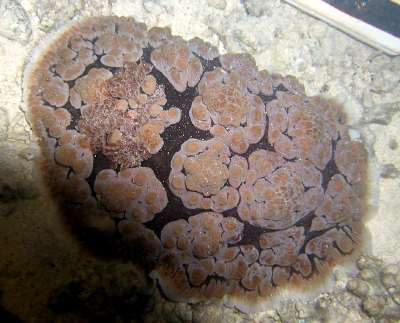
Hi,
participating to the invert mission for procfish (SPC) in Wallis, we found an enormous Dorid crawling by night in a big coral patch. I don't know what it is. Please, would any body help me to ID it?
Locality: Wallis Is, Wallis & Futuna Ids, Pacific Ocean. Depth: 2,5 mètres. Length: around 300 mm. 28 octobre 2005. intermediary reef in the lagoon, coral head. Photographer: Kim Friedman
Emmanuel Tardy
emmanuel_tardy@hotmail.com
Tardy, E., 2005 (Nov 3) ID of the biggest nudibranch I ever found!. [Message in] Sea Slug Forum. Australian Museum, Sydney. Available from http://www.seaslugforum.net/find/15165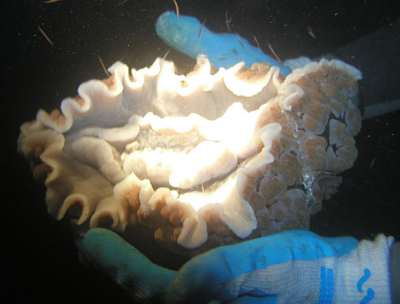
Dear Manu,
This is Dendrodoris carbunculosa. It was one of the largest reported nudibranchs. The largest we have on the Forum is one from Guam [message #1647] at 410 mm.
Best wishes,
Bill Rudman
Re: Dendrodoris carbunculosa with commensal shrimps
August 10, 2005
From: Barbara Hanchard
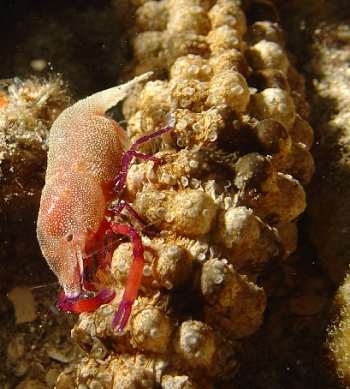
Yes Bill,
The commensal shrimp in my message [#14275] are Periclimenes imperator and are more commonly found on this site associated with various species of holothurians (see picture attached). Thanks for the correction on the dorid id.
Barbara
barbara.hanchard@ffa.int
Hanchard, N.B., 2005 (Aug 10) Re: Dendrodoris carbunculosa with commensal shrimps. [Message in] Sea Slug Forum. Australian Museum, Sydney. Available from http://www.seaslugforum.net/find/14523Thanks Barbara,
Bill Rudman
Dendrodoris carbunculosa with commensal shrimps
August 5, 2005
From: Barbara Hanchard
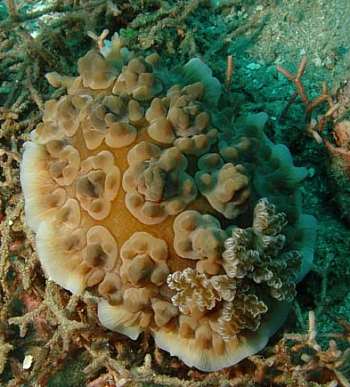
Dear Bill,
Today at 11.26am to be precise I found this Asteronotus cespitosus. I have seen several references to this droid being nocturnal. What would be the reason for it being observed in daylight hours? It had several shrimp piggy backing and I couldn't see any evidence of egg laying active.
Locality: Leilei, Honiara, Solomon Islands, Pacific Ocean. Depth: 12 meters
Length: 150 mm. 16 July 2005. sandy slope, some coral. Photographer: N. Barbara Hanchard
Regards
Barbara Hanchard
barbara.hanchard@ffa.int
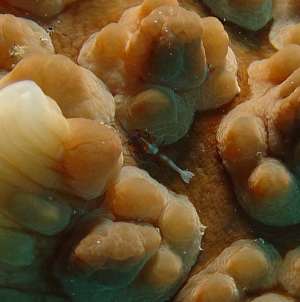

Dear Barbara,
This is certainly as ugly as a large Asteronotus but it is Dendrodoris carbunculosa - an ugly dorid with an ugly name. I suspect the commensal shrimps are Periclimenes imperator - but I could be wrong. It used to be thought that it was a specialised commensal of Hexabranchus, but it seems to be found on many large opisthobranchs.
Best wishes,
Bill Rudman
Dendrodoris carbunculosa from Anilao, The Philippines
May 17, 2005
From: Paul Osmond
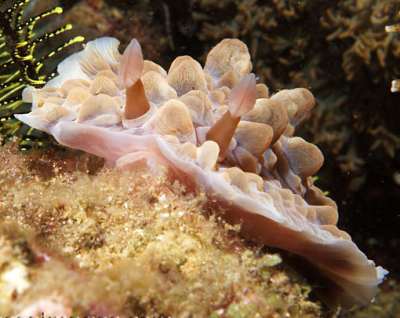
Bill,
Lets see if I can get one right :-)
This image taken in March 2004 is I believe of Dendrodoris tuberculosa from Anilao, The Philippines, although I am uncertain. This was the first time I had seen this species, so I was unaware of the white spots underneath that identify the species.
For a big nudibranch, this speciman was moving across the reef pretty fast (relative of course to other nusibranchs).
Locality: Planet Dive Shore Dive, Anilao, Batangas, The Philippines. Depth: 8 m. Length: 100 mm. 17 March 2004. Shallow Coral Reef, White Sand Bottom. Photographer: Paul T. Osmond
Enjoy,
Paul
www.deepseaimages.com
marriard@deepseaimages.com
Osmond, Paul T., 2005 (May 17) Dendrodoris carbunculosa from Anilao, The Philippines. [Message in] Sea Slug Forum. Australian Museum, Sydney. Available from http://www.seaslugforum.net/find/13706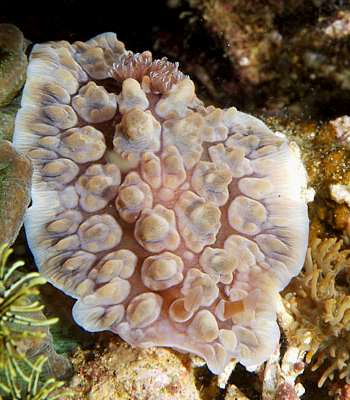
Dear Paul,
I'm afraid this is Dendrodoris carbunculosa, not D. tuberculosa. Although one easy way to separate them is the absence of white spots on the underside of the mantle skirt in D. carbunculosa, that's not much use from photos. However your photos show another quite good character, and that is the large tubercles each surrounded by a ring of small tubercles. In D. tuberculosa the tubercles are usually more complex with multiple tips,, and are not ringed by smaller tubercles. Usually the compound tubercles of D. tuberculosa are crowded together, not spaced as you can see her in D. carbunculosa.
Your upper photo shows the relatively stiff mantle skirt very well
Best wishes
Bill Rudman
Dendrodoris carbunculosa from Reunion Island
February 23, 2005
From: Philibert Bidgrain
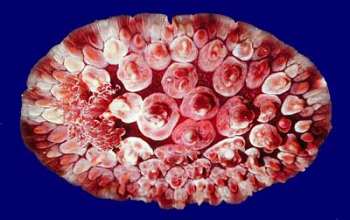
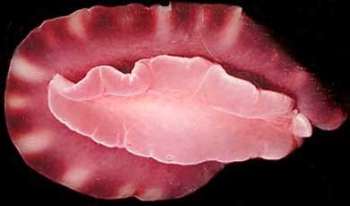
Dear Bill,
Reunion Island sea slugs.
We have only one specimen of Dendrodoris carbunculosa, which was onserved and photographed by Maurice Jay at "Cap Homard" lagoon at Saint Paul, at night. I send you two photos, the mantle with large tubercles surrounded by a ring of small semispherical bumps, and the underside of the mantle
Locality: "Cap Homard" lagoon at Saint Paul, Reunion Island, Indian Ocean.
Best Regards
Philibert Bidgrain
http://vieoceane.free.fr/runseaslug/indexslug.htm
pbidgrain@yahoo.fr
Bidgrain, P., 2005 (Feb 23) Dendrodoris carbunculosa from Reunion Island. [Message in] Sea Slug Forum. Australian Museum, Sydney. Available from http://www.seaslugforum.net/find/13161Thanks Philibert,
Best wishes,
Bill Rudman
Dendrodoris carbunculosa or what?
December 6, 2003
From: Tina Owens
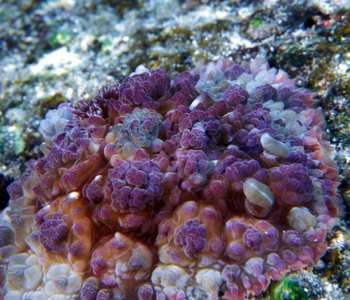
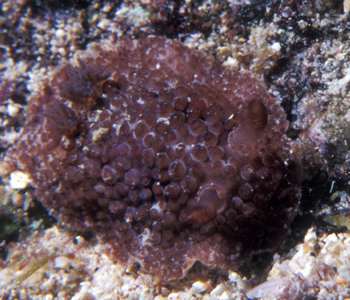
Dear Dr. Rudman:
I live and dive on the Kona Coast of the Big Island of Hawaii. On September 29th, I found a marvelous nudi that I assumed was a Dendrodoris tuberculosa. It was in about 10m depth of water and was probably 250mm long [upper photo]. Then about two weeks ago, a friend found what we assumed was a juvenile D. tuberculosa, from color, rhinophores and general bumpiness [middle photo]. - Found in 7m of water, about 40mm long. Then, last Sunday I found this creature [lower photo] which has really confused me. It was about 750mm long, found in 7m of water at a completely different dive site.
My friends thought it was a juvenile D. tuberculosa, since several of them have been found recently at that dive site However, I thought back to a message that D. Lundholm sent you (June 6, 2003) about a nudi that Sharon Williams found on the Kona Coast of Hawaii. You identified that animal as a juvenile D. carbunculosa. I think my mystery nudi could be a sub adult of that species because of the white spots with bumps on its back. The mantle edges seem to already be turning into the lumpy adult form.
The reason why I was confused is that, as far as I know, no one has ever found an adult D. carbunculosa in this area, yet S. Williams found a juvenile, and this may well be a juvenile, too. For the record, could you please identify all three photos?
Tina Owens
bob-tinaowens@hawaii.rr.com
Oowens, T., 2003 (Dec 6) Dendrodoris carbunculosa or what?. [Message in] Sea Slug Forum. Australian Museum, Sydney. Available from http://www.seaslugforum.net/find/11607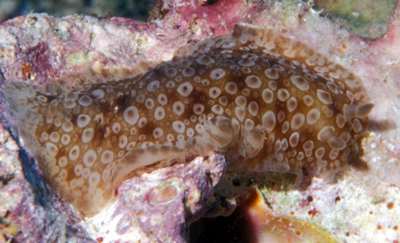
Dear Tina,
I think you have 3 different species here, which would explain your confusion. The upper one is definitely Dendrodoris carbunculosa. One good way to separate it from D. tuberculosa is that it has distinct white spots on the underside of the mantle. Both species have quite stiff bodies with fairly leathery mantles.
The animal in the middle photo could be the same as the one I tentatively identified from South Africa as D. carbunculosa [see Linda Penny's message]. It could also possibly be Hoplodoris, possibly Hoplodoris grandiflora but its a bit hard to make out whether the tubercles are simple and rounded.
The animal in the lower photo is definitely Dendrodoris albopurpura which is definitely a new record for Hawaii. It is much more elongate than D. carbunculosa and the body is much softer, the mantle much thinner, and definitely not stiff and rigid to touch.
Best wishes
Bill Rudman
Dendrodoris carbunculosa from Hawaii
August 28, 2003
From: Matthew Cummings
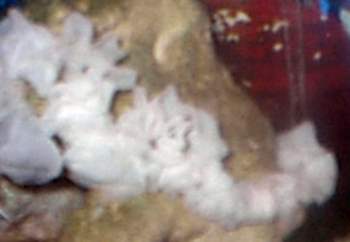
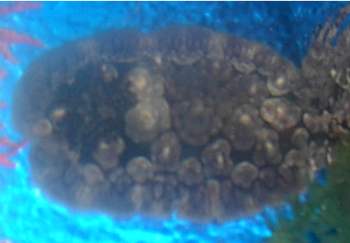
Hi Bill,
I currently have an approx. 6in Dendrodoris carbunculosa who just layed eggs. I know that these photos are not the best. the eggs are a silky looking ribbon that is approx. 1in high and is laid in a spiral formation on top off the rock work. This particular nudibranch I aquired off of the north shore of Oahu, Hawaii.
This is the first time i have tried to post anything on the net but here goes. I just thought that you may be interested in this. I have had it in captivity for approx. a month. It is doing fine it spends most of the day cruising the tank. Since adding this specimen I have not had any problems with the detritus algae. It is sharing a tank with a mated pair of coral banded shrimp collected the same night.
Matthew Cummings
mcalvin76@hotmail.com
Cummings, M., 2003 (Aug 28) Dendrodoris carbunculosa from Hawaii. [Message in] Sea Slug Forum. Australian Museum, Sydney. Available from http://www.seaslugforum.net/find/10853Dear Matthew,
Thanks for the message. Concerning its well-being. This animal is a sponge feeder - but it will require specific species of sponges, not just any old sponge. I suspect the reason you aren't haven't algal problems is not because the slug is eating the algae, but because its mucus trail, as it crawls around is killing the algae. I'm afraid laying eggs is also often a sign of stress. Unless you animal has found some appropriate sponge in your aquarium, it will be slowly starving to death
Sorry I can't be more positive
Bill Rudman
Dendrodoris carbunculosa Nudi From Batam
July 7, 2003
From: Alice Lee
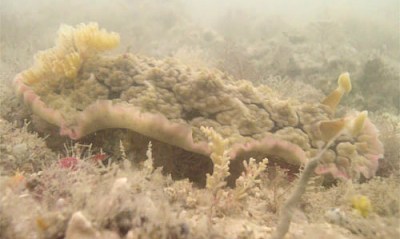

Hi Bill,
This nudibranch is nothing I ever seen before because it is huge, a friend of mine took this photos.
I have look thru Asteronotus family, it doesn't seems to match any of the photos there, can you help to identify it.
Taken at depth <10m.
Location: Batam, Indonesia
Size: 50cm
Thanks,
Alice Lee
alee@dlink.com.sg
Lee, A., 2003 (Jul 7) Dendrodoris carbunculosa Nudi From Batam. [Message in] Sea Slug Forum. Australian Museum, Sydney. Available from http://www.seaslugforum.net/find/10323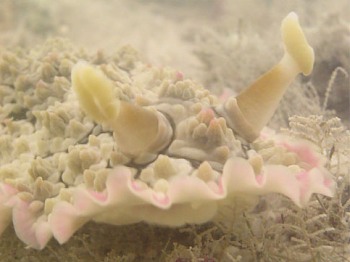
Dear Alice,
This is Dendrodoris carbunculosa. As you'll see from the Fact Sheet, and some of the ealrier messages, this grows to quite an enormous size
Best wishes,
Bill Rudman
Dendrodoris carbunculosa from Kona , Hawaii
June 6, 2003
From: Richard Lundholm
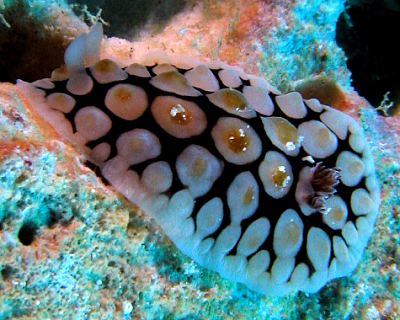
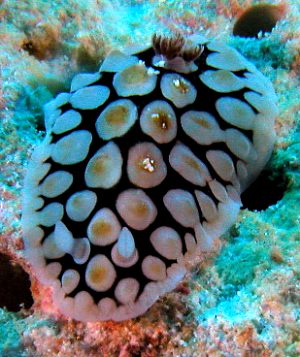
Dear Bill
The attached Nudibranch was found by my dive buddy, Sharon Williams, Sunday 18 May 2003 in 45ft of water off the Kona coast of Hawaii. We cannot find it in any of our Nudibranch books and seek your help in identifing it. Tina Owens gave me your web address, she is our Kona Underwater Photographic Society President.
Richard Lundholm
dicklundholm@hawaii.rr.com
Lundholm, R., 2003 (Jun 6) Dendrodoris carbunculosa from Kona , Hawaii. [Message in] Sea Slug Forum. Australian Museum, Sydney. Available from http://www.seaslugforum.net/find/10009Dear Richard,
This is a nice find. It is a colourful variant of Dendrodoris carbunculosa. You don't say how big the animal was, but this is one species which grows very large. If you scroll down the page and look at other messages on this species you will see we have records of it growing to at least 40cm long.
Best wishes,
Bill Rudman
Dendrodoris carbunculosa from Indonesia
March 15, 2003
From: Takako Uno
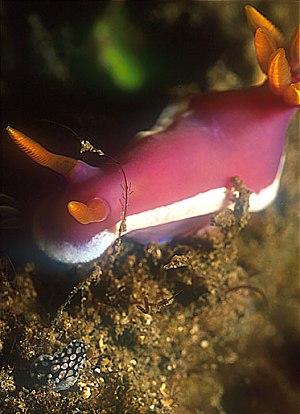
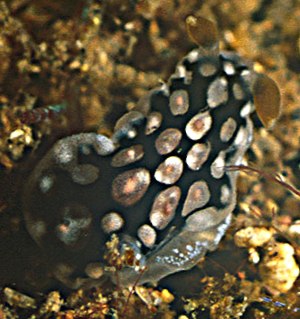
Dear Dr. Rudman,
Please kindly inform me, if I am correct in identifying the small nudibranch in the upper photo as a juvenile Dendrodoris tuberculosa. I have cropped out the smaller nudi and enlarged it the lower photo for a better view.
Is it a juvenile? It was near the Hypselodoris sp., and the little guy was about 8mm in length.
I took this photo in Lembeh Strait, North Sulawesi, Indonesia in December 2002. At about 12 meter, with water temperature 25 degrees Celsius. Photo: Takako Uno
Warmest regards and much thanks.
Takako Uno
divetoto@hotmail.com
Uno, T., 2003 (Mar 15) Dendrodoris carbunculosa from Indonesia. [Message in] Sea Slug Forum. Australian Museum, Sydney. Available from http://www.seaslugforum.net/find/9198Dear Takako,
It is definitely very small compared with the large pink Hypselodoris [Hypselodoris apolegma]. The little animal is a juvenile Dendrodoris but not Dendrodoris tuberculosa. Juveniles are often quite difficult to identify and this is no exception. It is Dendrodoris carbunculosa, which has until recently usually been confused with D. tuberculosa. The black or dark brown background colour on the mantle is often found in D. carbunculosa but never in D. tuberculosa. Also in D. carbunculosa the tubecules are much more scattered than in D. tuberculosa, where they are usually crowded together. I think this is the smallest juvenile I have seen of this species.
Best wishes,
Bill Rudman
Dendrodoris from South Africa
September 10, 2002
From: Linda Penny
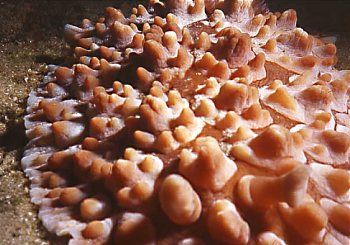
Dear Dr Rudman,
We can't decide whether this is a Dendrodoris carbunculosa or a Dendrodoris tuberculosa. What is your opinion? It was photographed by Laurette Hanekom off Sodwana, South Africa.
Many thanks,
Linda
lindapenny@netactive.co.za
Penny, L., 2002 (Sep 10) Dendrodoris from South Africa. [Message in] Sea Slug Forum. Australian Museum, Sydney. Available from http://www.seaslugforum.net/find/7871Dear Linda,
You don't give me a size, but I guess since it can't fit in the frame, it was quite large. From the dark patches you can see, and the fact that there is some space between the tubercles, I am pretty sure this is Dendrodoris carbunculosa.
Cheers,
Bill Rudman
Dendrodoris carbunculosa? from the Seychelles
June 16, 2001
From: Erwin Köhler
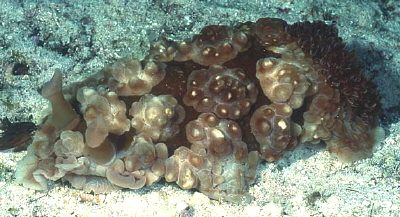
Dear Bill,
This one was made by Frank Gloystein (Frank.Gloystein@t-online.de) at the Seychelles, Bird Island on March 18, 2001, length about 15 cm, depth about 12 m.
Erwin
Erwin@medslugs.de
Köhler, E., 2001 (Jun 16) Dendrodoris carbunculosa? from the Seychelles. [Message in] Sea Slug Forum. Australian Museum, Sydney. Available from http://www.seaslugforum.net/find/4566Dear Erwin,
Yes this is Dendrodoris carbunculosa. The flattened compound tubercles are rather characteristic of this species.
Best wishes,
Bill Rudman.
Dendrodoris carbunculosa from East Pacific
September 1, 2000
From: Clinton Bauder
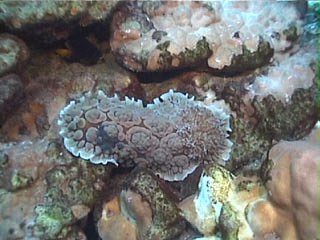
Bill,
Interesting that Dendrodoris tuberculosa should come up. I think I saw this slug at Cocos Island (Costa Rica - East Pacific) two years ago. Several experts looked at my images and concluded that it probably was Dendrodoris tuberculosa but that nobody had ever heard of it being reported from anywhere near that area.
This was a very large slug - at least 250mm, probably larger. Note the damselfish in the upper left. I have another image somewhere of a human hand and arm next to the slug but I seem to have misplaced that file. Unfortunately this is the best photo I've got. It's a still frame taken from video. I was doing a safety stop when the divemaster started banging on his tank. I went back down to 50 feet where the slug was and took about 30 seconds of video. Then, realizing that I didn't have much air left I bailed. I've since regretted not handing the camera off to the DM...
Clinton
www.metridium.com [Metridium Fields]
gecko1@apple.com
Dear Clinton,
This is a very interesting find. It would have been interesting if it was Dendrodoris tuberculosa, but I think it is another Indo-West Pacific species, Dendrodoris carbunculosa, which is equally interesting. I don't know of it being recorded from the eastern Pacific before.
It has the characteristic ring of small tubercles around each large tubercle, and the pale border is almost identical to Clay Carlson's photos from Guam.
Another 'species' which may be worth considering as part of the deal is Dendrodoris warta Marcus & Gallagher, 1976. It was described from west Florida, which is of course on the other side of the isthmus, but it wouldn't be the first species to be found on both sides. It was described as having a dark brown background with tan to pinky-beige variably sized tubercles all over the mantle. . Rhinophores with white lamellae and tips. Underside of mantle uniformly lighter than the dorsal surface. Egg ribbon a ruffled orange spiral. Interestingly the animals found were on oysters (Crassostrea) feeding on an orange encrusting sponge. Looking at the black & white photos in the description the tubercles seem somewhat more crowded and the tubercles a bit different but they seem to have a central 'nipple' surrounded by a ring of smaller tubercles. Up tp 12 cm long alive.[Marcus, Ev & Gallagher, S.B. (1976) A new species of Dendrodoris from Florida. The Veliger, 18(4): 353-356.]
Externally your animal looks identical to D. carbunculosa. Whether D. warta is a synonym or not will need a closer look, but it is worth keeping in mind.
Best wishes,
Bill Rudman.
Dendrodoris carbunculosa from Sulawesi
April 1, 2000
From: Lindsay Warren
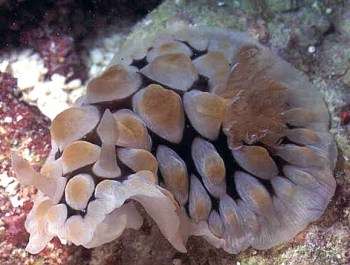
Dear Bill
This specimen was found by Graham Abbott at 11.30am on 6 September 1999 at a depth of 23.7 m on coralline algae on a wall of Pulau Hoga [Tukang Besi Archipelago, SE Sulawesi, Indonesia - Operation Wallacea]. Size: 32 mm.
The underlying mantle colour is off-white with black surrounding large tubercles. These have a white base and are capped with orangey brown. The branchial plume is complex, large and orangey brown in colour. The rhinophores are club shaped and retractile, white with a dusting of brown.
Photo: Lindsay Warren
What do you reckon it is?
All the best
Lindsay Warren
100014.2112@compuserve.com
Warren, L., 2000 (Apr 1) Dendrodoris carbunculosa from Sulawesi. [Message in] Sea Slug Forum. Australian Museum, Sydney. Available from http://www.seaslugforum.net/find/2183Dear Lindsay,
This is Dendrodoris carbunculosa, a spectacular large dendrodorid which has often been confused with Dendrodoris tuberculosa.
Best wishes,
Bill Rudman.
A larger Dendrodoris carbunculosa
December 8, 1999
From: Clay Carlson & Patty Jo Hoff
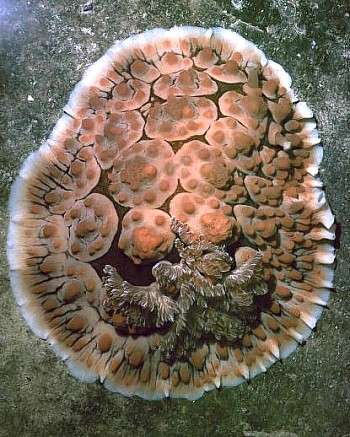
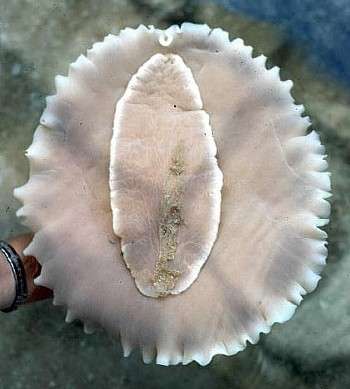
Bill,
Glad another name showed up for the plain bottomed forms. We have been bothered for some time with the apparent two forms for Dendrodoris tuberculosa.
Here is a record of D. carbunculosa which is slightly larger than Yoshi's.
Data: 410mm; Guam, Apra Harbor, 14m; 6 April 1993. leg. Butch Irish, UOG Marine Lab.
Clay & Patty Jo
clay.carlson@kuentos.guam.net
Carlson , C. & Hoff, P.J., 1999 (Dec 8) A larger Dendrodoris carbunculosa. [Message in] Sea Slug Forum. Australian Museum, Sydney. Available from http://www.seaslugforum.net/find/1647Thanks Clay & Patty Jo,
It is certainly a spectacular animal, especially in this colour form.
Best wishes,
Bill Rudman.
re: Dendrodoris carbunculosa
December 1, 1999
From: Yoshi Hirano
Dear Bill,
Thank you for the wonderful forum pages of today. I learned a lot from them and re-recognized the world is always full of wonders and surprises. I was so impressed by the presence of the 520 mm long example of Hexabranchus sanguineus in Red Sea!
Many thanks again.
Take care,
Best wishes,
Yoshi
hiranoyj@earth2.s.chiba-u.ac.jp
Hirano,, 1999 (Dec 1) re: Dendrodoris carbunculosa. [Message in] Sea Slug Forum. Australian Museum, Sydney. Available from http://www.seaslugforum.net/find/1629Is this the largest nudibranch?
November 30, 1999
From: Yoshi Hirano
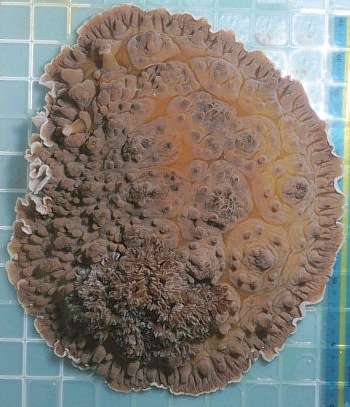
Dear Bill,
A technician of our laboratory found a very large dorid nudibranch in nearby port this week. It measures more than 350 mm long! I am not familar with the species. I took these pictures in the aquarium. By the way, do you know what is the biggest record of body size for nudibranchs?
The colour of our specimen is dorsally quite dark brown overall. It weighs 2 kg! The tubercle patterns of the present species seem to consist of large tubercles, each of which is surrounded by several small ones. The secondary gills remind me of those of Dendrodoris. Can this species be Dendrodoris tuberculosa? I hope to hear your suggestions.
I measured the animal in the relaxed condition in a tide pool. It was 35 cm long. Out of water, flattened on the laboratory sink it was 40 cm in length
Data: Amatsu-Kominato, Boso Peninsula, central Japan. 35 07N, 140 11E. Found near the surface on the concrete wall of a fishing port. 23rd November, 1999. Still alive at Kominato Marine Laboratory Aquarium. The maximum length is 40 cm. The wet weight is 2 kg. Photo: Yoshi J. Hirano.
I hope all is well with you and am hoping to hear from you.
Best wishes,
Yoshi
hiranoyj@earth2.s.chiba-u.ac.jp
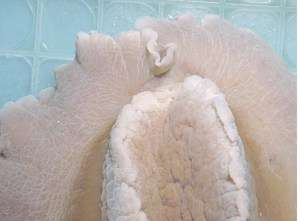
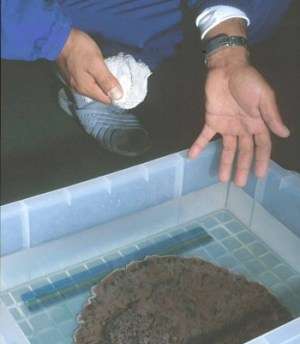
Dear Yoshi,
Your animal is Dendrodoris carbunculosa Kelaart, 1858 which has usually been confused with Dendrodoris tuberculosa. I have prepared new pages on both these species to show the differences.
I knew this species grew quite large but I don't know of one reaching your 350 - 400mm range.
Concerning the largest sea-slug, nudibranch etc. By coincidence, I have just received a message from Amelia Campbell asking the very question, so I have started a page for the largest, smallest, fastest etc sea slug. Any contributions are welcome. Have a look at my answer to her question.
Best wishes,
Bill Rudman.
Dendrodoris tuberculosa & D. carbunculosa
November 30, 1999
From: Bill Rudman
I have added pages on Dendrodoris carbunculosa and Dendrodoris tuberculosa.
Bill Rudman.
Dendrodoris carbunculosa from Philippines
December 20, 1998
From: Erwin Koehler
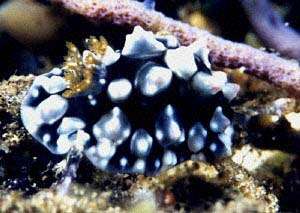
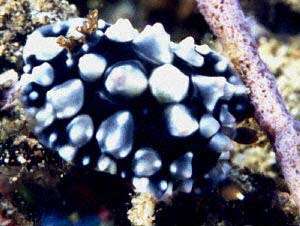
Dear Bill
These photos were made at Dauin, Negros, Philippines, (October 1998). I did only the 2 shots, we were looking for seahorses at this dive site (and found 2) and I almost lost my buddies, so I had to hurry. Size about 2cm, depth 23m.
Erwin
E.Koehler@deutschepost.de
Koehler, E., 1998 (Dec 20) Dendrodoris carbunculosa from Philippines. [Message in] Sea Slug Forum. Australian Museum, Sydney. Available from http://www.seaslugforum.net/find/412Dear Erwin,
I am pretty sure this is Dendrodoris carbunculosa. It was described by Kelaart from Ceylon (Sri Lanka) which has either been ignored or considered a synonym of Dendrodoris tuberculosa. Perhaps they are just extreme forms of one species but I have not seen any intermediates.
Bill Rudman.
